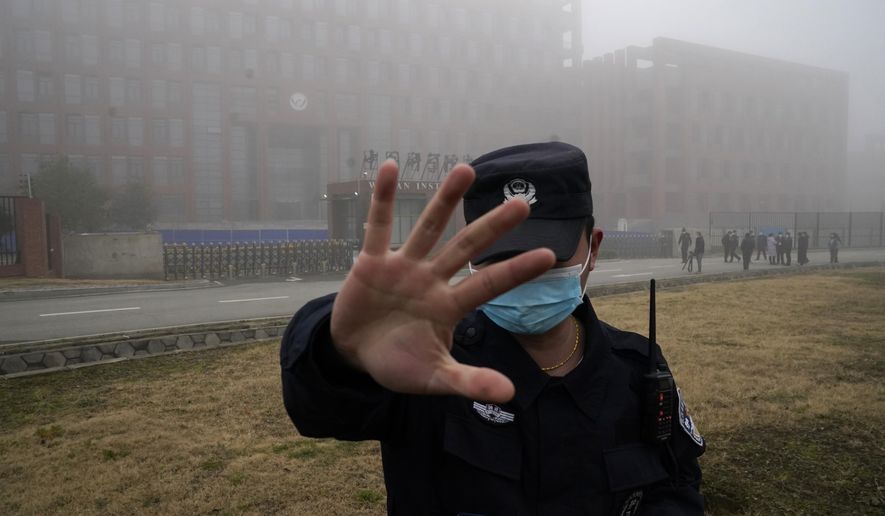The COVID-19 virus most likely originated from a government laboratory in Wuhan, China, and not from a wild animal, according to a new report by Republicans on the Senate Health, Education, Labor and Pensions Committee.
The report, by the minority members of the Senate panel, also said that the origin of the virus remains unknown mainly due to the Chinese government’s lack of cooperation.
“Nearly three years after the COVID-19 pandemic began, substantial evidence demonstrating that the COVID-19 pandemic was the result of a research-related incident has emerged,” the interim report by the minority staff concludes. “A research-related incident is consistent with the early epidemiology showing rapid spread of the virus in Wuhan, with the earliest calls for assistance being located near the [Wuhan Institute of Virology’s] original campus in central Wuhan.”
China’s Communist regime has angrily denied the lab leak theory and has blocked sharing or publishing any information on the virus behind COVID, known as SARS-CoV-2, without state review and approval. The restrictions remain in place today.
Contrary to Chinese government claims, the first cases of the disease appeared to surface in mid-October or early or mid-November 2019.
The other theory behind the virus is that it emerged from human infections after contact with animals, perhaps at the wet market in Wuhan. The report said there is less evidence for such a zoonotic transfer of the virus.
“Almost three years after the COVID-19 pandemic began, there is still no evidence of an animal infected with SARS-CoV-2, or a closely related virus, before the first publicly reported human COVID-19 cases in Wuhan in December 2019,” the report said.
If an animal was the source, there is no known species that has emerged as a candidate and no clues as to where the animal was first infected, the report said.
“While it is likely that SARS-CoV-2 originated from a bat virus, most likely one found in horseshoe bats residing in Southern China or Southeast Asia, it remains unknown how SARS-CoV-2 traveled more than 1,000 miles from Southern China or Southeast Asia before emerging in Wuhan,” the committee report said.
Additionally, committee investigators also determined that the COVID pandemic outbreak differed from earlier virus spillovers that have been traced to an animal host.
The panel based its assessment on coronavirus research conducted at the Wuhan Institute of Virology in collaboration with Western scientists.
“The WIV is an epicenter of advanced coronavirus research that was designed to predict and prevent future pandemics by collecting, characterizing and experimenting on ‘high-risk’ coronavirus with the potential to spill over into humans,” the report said.
The institute collected more than 15,000 samples from bats and identified more than 1,400 bat viruses, including an estimated 100 sequences of SARS-related coronaviruses — the type of coronaviruses linked to SARS-CoV-2.
The Wuhan laboratory’s database of those viruses was taken offline in September 2019.
Additionally, WIV coronavirus researcher Shi Zhengli disclosed beginning in 2018 that her team had infected civet and humanized mice with laboratory-manipulated SARS-related coronaviruses.
The EcoHealth Alliance, a New York-based research group, made grant proposals to the National Institutes of Health and the Defense Advanced Research Agency for conducting genetic experiments on coronaviruses that made the viruses a “high risk” for zoonotic spillover into animals and humans.
“SARS-CoV-2 shares many of the traits these researchers were interested in finding in SARS-related coronaviruses or interested in engineering such traits if they were not found naturally,” the report said.
Senate investigators also found that the Wuhan lab experienced six bio-safety failures in 2019 and 2020 related to the containment of an aerosolized respiratory virus like COVID-19.
The COVID outbreak also differed from the prior outbreaks of SARS, Middle East Respiratory Syndrome and multiple avian flu outbreaks, which were much less transmissible among humans than SARS-CoV-2.
If the COVID-19 pandemic originated naturally in an animal host, “there should be evidence of SARS-CoV-2 circulating in animals before it spilled over into humans,” the report said. “Instead, there is no evidence that any animal was infected with SARS-CoV-2 prior to the first human cases.”
The Senate report is more definitive than two earlier origin investigations by the World Health Organization and the Office of the Director of National Intelligence.
Neither of those investigations was able to say whether an animal or a lab leak cause the pandemic.
“Over one million Americans have died from COVID-19 and tens of millions have died from this virus worldwide,” said Sen. Richard Burr, North Carolina Republican and ranking member of the committee. “With COVID-19 still in our midst, it is critical that we continue international efforts to uncover additional information regarding the origins of this deadly virus.”
A former Trump administration official involved in virus origin investigations said even the new Senate report lacked teeth and failed to make strong recommendations, such as demanding answers from China or limiting U.S. gain-of-function research.
“We’re still fighting over how the pandemic happened and have to stop debating whether the origin is zoonosis or lab release,” the former official said. “What is needed are hard-hitting recommendations for reform [at NIH] and actions that hold China accountable.”
Fresh concerns about dangerous virus research were raised recently by House Republicans following reports that a Boston University laboratory experimented in creating a new strain of the COVID-19 virus.
The State Department fact sheet made public in the last days of the Trump administration provides key clues to the virus’s origin, including new links to the Wuhan Institute of Virology. The report identified WIV experiments involving RaTG13, the bat coronavirus identified by the lab in January 2020 as 96% similar to SARS-CoV-2.
WIV also carried out gain-of-function research to engineer more contagious viruses.
The U.S. contends that, contrary to claims by Chinese officials, the Wuhan facility also carried out secret projects with the military, including animal experiments.
For more information, visit The Washington Times COVID-19 resource page.
• Bill Gertz can be reached at bgertz@washingtontimes.com.




Please read our comment policy before commenting.